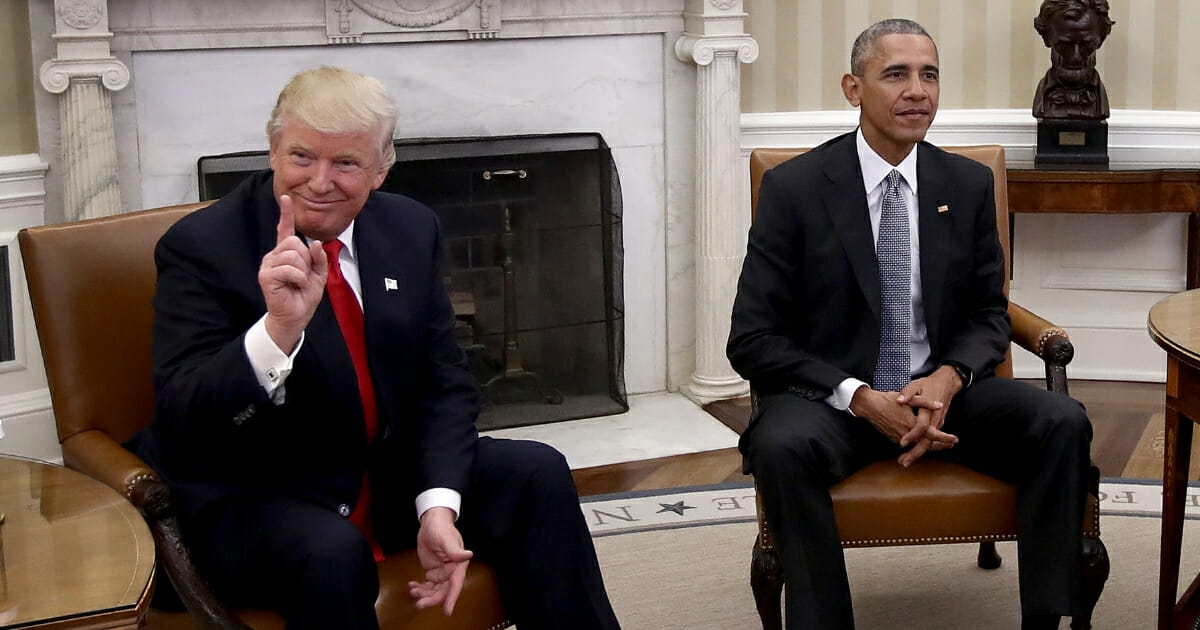
Here’s How Trump’s Environmental Legacy Stacks Up with Obama’s Record
- President Donald Trump’s environmental record has benefited from an increase in natural gas production while coal stumbles.
-
Oil production saw some of its biggest gains during the Trump and Obama administrations.
- Greenhouse gas emissions have fallen to record lows under Trump recently, while emissions slowly crept up during the latter part of Obama’s first term.
President Donald Trump’s environmental record during his first term in office has mirrored his Democratic predecessor’s in some ways and deviated substantially in others.
Former President Barack Obama’s legacy was littered with regulations targeting the coal industry and executive orders designed to reduce gas production. Such measures were expected to help reduce greenhouse gas levels, among other pollutants, but factors complicated the mission. Trump, meanwhile, is seeing a dip in carbon emissions.
Here are the biggest differences and similarities between the Trump and Obama administrations with respect to environmental stewardship and energy production.
Emissions Dropped During Both Administrations
Carbon emissions are expected to decline by 2.5 percent in 2019 after increasing in 2018, the Energy Information Administration noted in a Sept. 10 report. The decline comes after emissions jumped 2.8 percent in 2018 — the largest year-to-year rise since 2010.
Higher emissions in 2018 were a result of an unusually hot summer and cold winter, as well as an increase in manufacturing activity, according to the EIA. Trump saw a dip during his first year, reports show.
The EIA, for instance, reported in 2018 that per-capita greenhouse gas emissions hit a 67-year low at the beginning of the Trump era. Such emissions rose to historic highs globally by the end of that year, despite nearly 200 countries signing the Paris climate accord, which Trump promised to leave in 2017.
Obama’s record in this area is more complicated. Greenhouse gas emissions rose between 2012 and 2013, the EPA reported in 2015, despite the former president’s best efforts to reduce gases activists say will cause catastrophic global warming.
There was a “two percent increase in greenhouse gas emissions in 2013 from 2012 levels, but a nine percent drop in emissions since 2005,” the EPA reported in 2015. Much of the initial decrease before those years was due in part to the economic recession in 2007, which reduced manufacturing. The economy’s recovery in 2012 contributed to the increase.
Trump Is Taking a Hammer to Obama’s Regulator Regime
The president announced a rollback of one environmental regulation in December 2018 restricting greenhouse gas emissions from coal power plants. He also announced rollbacks in 2018 to an Obama-era policy requiring gas companies to strictly monitor releases of methane from wells.
Conservative analysts have championed the president’s style. Trump’s first term has been a net benefit to the environment, according to Myron Ebell, an analyst at the Competitive Enterprise Institute who headed the president’s transition team for the Environmental Protection Agency.
“The Trump administration is making progress in undoing damage done by the Obama administration’s extremist environmental agenda,” Ebell told The Daily Caller News Foundation before listing a slew of rollbacks Trump performed that he claims are helping the economy and environment.
He added: “That’s a huge step forward for the economy as well as the environment.”
Ebell said Trump’s decision to withdraw from Obama’s Waters of the United States rule, which sought to regulate waterways, was ultimately a “huge step for the environment” in that it allowed regulators to focus instead on air, water and land pollution.
Trump is responsible for nixing more than 85 environmental regulations, media reports show. He’s axed rules governing pollution, oil drilling and extraction, toxic substances, and water pollution, among a handful of other activities that affect industry.
Trump Took a Hatchet to Most of His Predecessor’s Anti-Fossil Fuel Rules
Obama’s so-called Clean Power Plan, which required states to make deep cuts to power sector emissions, never went into effect. The U.S. Supreme Court issued a stay on its implementation in 2016, and Trump’s EPA’s ultimately ended the rule, replacing it with the Affordable Clean Energy rule, which only requests states improve coal plant efficiency.
Along with targeting coal production, Obama also pursued regulations preventing new fracking operations on public lands. Presidents have few ways to limit such forms of energy production on private land, so the former president instead focused on restricting energy producers access to public lands.
Obama announced the CPP in 2015 to curb man-made climate change — the new regulatory plan favored energy sources like wind and solar over traditional fossil fuels like coal and natural gas. Natural gas contains methane, a gas that scientist say contributes heavily to global warming.
Trump ultimately nixed Obama’s anti-fracking policy in December 2017, under the belief that the regulations hurt manufacturers and hurt the economy. Energy analysts and lobbyists for the industry generally supported the move at the time, with some saying the regulation was burdensome.
A major reason the U.S. has been able to slash emissions is the availability of low-priced natural gas. Drillers have been able to use hydraulic fracturing and horizontal drilling over the past decade to unlock vast shale gas reserves. Low-priced gas has replaced much U.S. coal-fired capacity in recent years, which has in turn lowered emissions.
Oil and Gas Shot Up During Both Obama and Trump’s Terms
Oil production on federal lands and waters hit record highs in 2017, according to federal data, averaging about 2.2 million barrels per day. Overall oil production on federal lands increased during Obama’s second term, even though drilling supporters said the administration had put up more regulatory hurdles.
The number of new wells drilled on federal lands fell 83 percent from 2008 by the end of Obama’s second term, according to Bureau of Land Management data from 2017. New leases fell 78 percent and the number of permits approved fell 67 percent, according to BLM.
Obama signed legislation in late 2015 ending the decades-old ban on crude oil exports. U.S. oil production doubled between 2009, when Obama took office, and 2016, while natural gas production shot up 50 percent in that time.
The boom took place on state and private lands where the Obama administration had little to no control.
Trump reaped many of the benefits. Imports from OPEC fell to 1.5 million barrels per day in March, which is the lowest level since March 1986, the EIA reported in June. The EIA said at the time that OPEC imports fell “as domestic crude oil production has increased.”
Former President Ronald Reagan was in office and Halley’s Comet was visible in the night’s sky the last time Americans depended more on domestic production than on OPEC oil.
Content created by The Daily Caller News Foundation is available without charge to any eligible news publisher that can provide a large audience. For licensing opportunities of our original content, please contact licensing@dailycallernewsfoundation.org.
A version of this article appeared on The Daily Caller News Foundation website.
Truth and Accuracy
We are committed to truth and accuracy in all of our journalism. Read our editorial standards.
Advertise with The Western Journal and reach millions of highly engaged readers, while supporting our work. Advertise Today.












